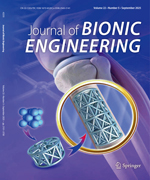|
|
An Improved Golden Jackal Optimization Algorithm Based
on Multi‑strategy Mixing for Solving Engineering Optimization
Problems
Jun Wang, Wen-chuan Wang, Kwok-wing Chau, Lin Qiu, Xiao-xue Hu, Hong-fei Zang & Dong-mei Xu
Journal of Bionic Engineering. 2024, 21 (2):
1092-1115.
DOI: 10.1007/s42235-023-00469-0
Nowadays, optimization techniques are required in various engineering domains to fnd optimal solutions for complex
problems. As a result, there is a growing tendency among scientists to enhance existing nature-inspired algorithms using
various evolutionary strategies and to develop new nature-inspired optimization methods that can properly explore the feature
space. The recently designed nature-inspired meta-heuristic, named the Golden Jackal Optimization (GJO), was inspired by
the collaborative hunting actions of the golden jackal in nature to solve various challenging problems. However, like other
approaches, the GJO has the limitations of poor exploitation ability, the ease of getting stuck in a local optimal region, and
an improper balancing of exploration and exploitation. To overcome these limitations, this paper proposes an improved GJO
algorithm based on multi-strategy mixing (LGJO). First, using a chaotic mapping strategy to initialize the population instead
of using random parameters, this algorithm can generate initial solutions with good diversity in the search space. Second, a
dynamic inertia weight based on cosine variation is proposed to make the search process more realistic and efectively bal�ance the algorithm's global and local search capabilities. Finally, a position update strategy based on Gaussian mutation was
introduced, fully utilizing the guidance role of the optimal individual to improve population diversity, efectively exploring
unknown regions, and avoiding the algorithm falling into local optima. To evaluate the proposed algorithm, 23 mathematical
benchmark functions, CEC-2019 and CEC2021 tests are employed. The results are compared to high-quality, well-known
optimization methods. The results of the proposed method are compared from diferent points of view, including the quality
of the results, convergence behavior, and robustness. The superiority and high-quality performance of the proposed method
are demonstrated by comparing the results. Furthermore, to demonstrate its applicability, it is employed to solve four con�strained industrial applications. The outcomes of the experiment reveal that the proposed algorithm can solve challenging,
constrained problems and is very competitive compared with other optimization algorithms. This article provides a new
approach to solving real-world optimization problems.
Related Articles |
Metrics
|

 Table of Content
Table of Content
 Table of Content
Table of Content